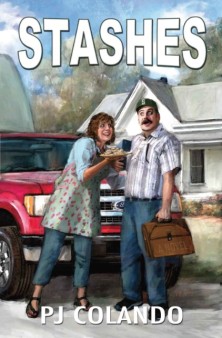I know them well; watched them grow up alongside me. Grow up, grow gray, grow weary—all hastened by escapades between those commas.
 Jackie and Steve Breeden live on a small farm, the vintage dream of the American Midwest. The vast fields surrounding their home have long been held by Steve’s family, but are cash-rented to neighbors who possess fresh burnished resolve. Buttressed by a longer line of credit at the bank and buffered by younger bones.
Jackie and Steve Breeden live on a small farm, the vintage dream of the American Midwest. The vast fields surrounding their home have long been held by Steve’s family, but are cash-rented to neighbors who possess fresh burnished resolve. Buttressed by a longer line of credit at the bank and buffered by younger bones.
The couple have earned a contented life. Their gravel lane undulates a rise and their farmhouse aligns like a nose between two cheek-like hills under the eyes of God.
Robert Frost would have composed a poem just for them, if he lived in their time.
My name is Fran Blackstone, and I’ve just retired as principal of the high school. Not the one that I attended with Jackie and Steve—that was downgraded to the middle school when consolidation came-but the new single level rambler made of brick the color of soil before rain. Behind it is a parking lot sided by a basketball arena, a baseball field, and a stadium with a track wrapped around the football field like a scarf. The communal lot’s an asphalt ocean awaiting van-and-carloads of people. God forbid that any of these sports seasons should overlap.
Midwesterners believe that sports were surely ordained by His spirit. It’s no secret that Pastor Paul Rankin covets the sports events attendance for his church.
Brandon Breeden, Steve and Jackie’s only child, was the reason that the sports-themed school was built. The term, “athletic grace”, does not capture his spectacular prowess. His play was magnificent, adroitly poised on perfection in every instant. Sports writers from The Detroit Free Press came, not to report on him, for the city was miles away, but for the privilege of witness.
Though Brandon activated a perfect storm of boyhood’s jubilant energy, his adult life is a craven imitation of his family heritage. Neither the misfortunes of the current economy nor his immaturity explain his messy lack of commitment; his aimlessness cannot be consigned to the unfortunate honeymoon accident that ended his pro football aspirations half-dozen years ago.
If he’d been my son, I’d have looked like the American Gothic painting’s couple. I’d have stuck the pitchfork in him. But Steve remained stoic, and Jackie kept shiny smiling. They did try to ditch the scene in an RV road trip, but it didn’t last overlong. Farmers cannot be capricious, despite a Baby Boomer yen for self-actualization and fun.
When I was in high school, I used to gaze at Grant Wood’s ‘American Gothic’, aloft on the study hall wall. I was a good student. Homework rapidly done, I’d daydream about the small, white house with its exotic, church-like window—anything to ward off thoughts of teenage angst or Vietnam, which played out nightly during supper on our television. My mother wouldn’t let me read during a meal, but I could daydream with my eyes straight at the screen, glazing the news’ reality.
My mind’s eye bypassed the couple’s glum expressions, miscast against the agrarian reverence connoted by the house’s window. Perhaps they lost a son to war and set themselves apart from happiness.
So I moved my imagination inside the home to create good lives; I was early a devoted enabler. I parted the lacy window curtains and peered into a young girl’s room, painted mint with daisy chains rimming the walls near the white summer cloud ceiling. The girl was prone on her bed, blond braids splayed across her shoulders to nearly touch her daisy-covered bedspread. She was bent over a drawing tablet with pastels, working out the muscles of her favorite horse. She frowned when her mother called her to help with supper chores, feathering one last line in the tail. Sometimes my ingénue had posters of the Beatles; sometimes of Herman’s Hermits, the Kinks, or the Rolling Stones, and their music played in my invisible headphones until my dad shouted to stop my eating utensil drumming on my plate.
Sometimes the room was golden, with sunset shadows shifting across perky wallpaper. Sometimes it was a boy’s room with a Cowboys and Indians comforter and Lincoln Logs strewn about. Sometimes a Slinky fell from a desk to a chair, then the floor, poked by my omniscient hand.
But the pallid couple remained the gatekeepers of teenage catharsis. I couldn’t get past them, no matter what. Why were they unsmiling, dour when they were living the dream? Our community’s promises lay all around us, in fields so well furrowed that even snow drifted in sync with the grooves. Fields with sweat, labor, and some tears, but not blood.
These puzzlements became hilarious when I took an art history course: the model for the pitchfork-holding farmer with the clamped lips had been a dentist. Not proud of his teeth after all that Fluoride and floss? Go figure. https://www.khanacademy.org/humanities/art-1010/art-between-wars/american-art-wwii/v/grant-wood-american-gothic-1930
The farmers I know are well humored. They proudly regard themselves as ardent caretakers of God’s land. They earn their keep, with or without His help. The land may bring them closer to God, but keeps them as distant as needed in a clan, a community, even in a couple. There’s all that toil, little time or energy for talk.
As a retiree, I’ve got a little time on my hands and beaucoup stories in my tape recorder brain—while the men folk don’t talk, their wives do. I’m sharing this sequel to STASHES because my friend Jackie wants to star in the movie—before her conniving ex-daughter-in-law beats her to it. That girl’s name is Amy, a sequence of letters in infamy, which is what she brought to all our lives.
Doncha wanna know about the past of this prologue? Here’s your link: http://www.amazon.com/Stashes-PJ-Colando-ebook/dp/B00LIAZBKK/ref=sr_1_1?s=books&ie=UTF8&qid=1447870114&sr=1-1&keywords=Stashes
Remember that Cliff Cramp, famed illustrator of all STAR WARS DVD cover art, created the book cover, putting himself in Steve Breeden’s shoes and signing it nearby = STASHES cover is a signed work of art!


Recent Comments